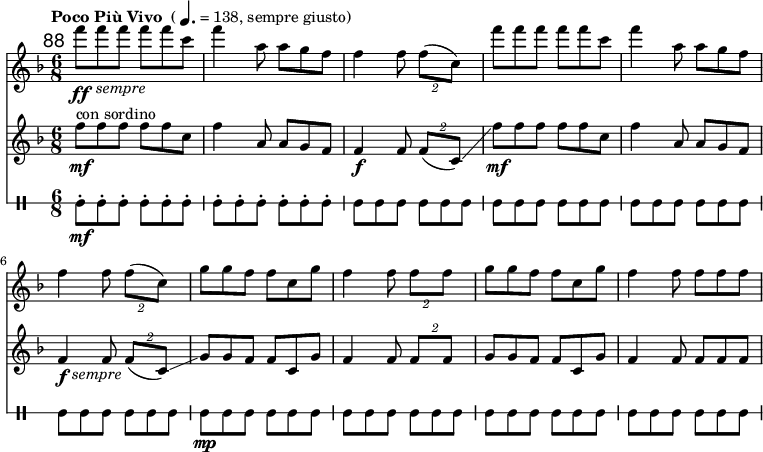印第安交响曲
《印第安交响曲》(Sinfonía india)是墨西哥作曲家卡洛斯·查维斯的交响作品,属于他第二首交响曲,于1935-36年间创作,被誉为是查维斯的代表作。本作品采用单乐章结构写成,但仍可分为三个小“乐章”,各小乐章均配以一首传统墨西哥北部的印第安人旋律所发展出来。
创作背景[编辑]
作品于1935年12月起开始创作,这时查维斯正藉在美国作首次的公演,翌年年初即于纽约完成,随即便于1月23日在一个电台演奏会中由哥伦比亚广播公司交响乐团作首次演出,同时4月10日由波士顿交响乐团作音乐会首演。至于墨西哥国内首演则于同年7月31日举行[1]。由于音乐具有原住民色彩,亦反映了作曲家对自己民族的身份认同,很快便在美洲地区普及起来,及后更为其他地方所认识。
配器[编辑]
本曲采用浪漫主义音乐时期的规模,其中敲击乐器采用了大量印第安“亚基部落”(Yanqi)所使用的乐器。当席尔默公司出版乐谱时,把这些亚基乐器改以接近西洋乐团中类近的敲击乐器代替,并在乐器页中描述相关的乐器对应。
- 木管乐器:2短笛(其中第2短笛兼任第3长笛、2长笛、3双簧管、E♭调高音单簧管、2B♭调单簧管、B♭调低音单簧管、3巴松管
- 铜管乐器:4圆号、2小号、2长号
- 敲击乐器:定音鼓、印第安鼓、沙槌、金属摇铃、吊钹、中鼓、纸板摇铃、击木、木琴、小鼓、木摇铃、刮瓜、大鼓、㓤棒
- 斜体文字为替代乐器
1971年席尔默公司出版了由弗兰克·威廉·埃里克森改编的管乐团版本乐谱,这个改编虽然未有得到查维斯的正式认可,然而他也曾指挥过这版本,亦作出了一些修正[2]。
全曲演奏时间约为 12-13 分钟。
乐曲分析[编辑]
- 引子(第1式)(单簧管、低音单簧管、巴松管、中提琴、大提琴)

- 引子(第2式)(小号)

- 引子(第3式)(所有木管乐器)

- 第1主题 (双簧管、第一小提琴)

- 第2主题 (E♭ 调单簧管、B♭调单簧管、中鼓)

- 第3主题 (圆号、长笛、弱音小号及长号)

- 终段 (E♭调单簧管、弱音小号、刮瓜)

外部链接[编辑]
注释[编辑]
- ^ Slonimsky, Nicolas (1945):Music of Latin America. New York: Thomas Y. Crowell Company,第234页。
- ^ Parker, Robert L. (1983):Carlos Chávez, Mexico's Modern-Day Orpheus. Twayne's Music Series. Boston: Twayne Publishers. ISBN 0-8057-9455-7,第72页。







